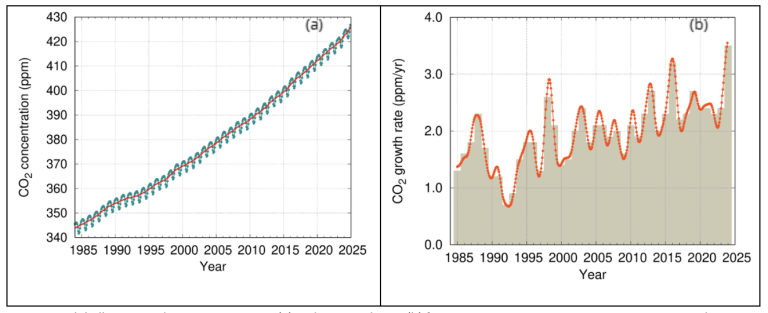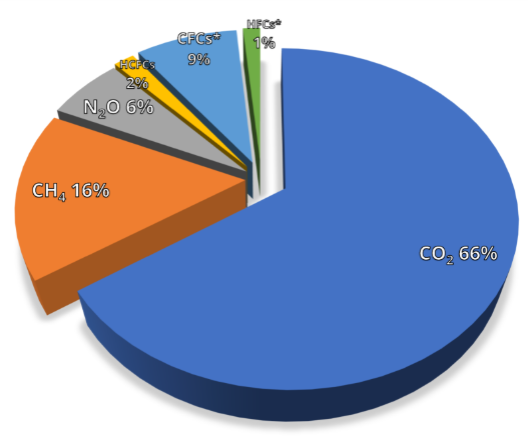Carbon dioxide – continued emissions and less effective carbon sinks
When the bulletin was first published in 2004, the annual average level of CO2 measured by WMO’s Global Atmosphere Watch network of monitoring stations was 377.1 ppm. In 2024 it was 423.9 ppm.
About half of the total CO2 emitted each year remains in the atmosphere and the rest is absorbed by Earth’s land ecosystems and oceans. However, this storage is not permanent. As global temperature rises, the oceans absorb less CO2 because of decreased solubility at higher temperatures, whilst land sinks are impacted on a number of ways, including the potential for more persistent drought.
The likely reason for the record growth between 2023 and 2024 was a large contribution from wildfire emissions and a reduced uptake of CO2 by land and the ocean in 2024 – the warmest year on record, with a strong El Niño.
During El Niño years, CO2 levels tend to rise because the efficiency of land carbon sinks is reduced by drier vegetation and forest fires – as was the case with exceptional drought and fires in the Amazon and southern Africa in 2024.
“There is concern that terrestrial and ocean CO2 sinks are becoming less effective, which will increase the amount of CO2 that stays in the atmosphere, thereby accelerating global warming. Sustained and strengthened greenhouse gas monitoring is critical to understanding these loops,” said Oksana Tarasova, a WMO senior scientific officer.
Today’s CO2 emissions to the atmosphere not only impact global climate today, but will do so for hundreds of years because of its long lifetime in the atmosphere.

Globally averaged CO2 concentration (a) and its growth rate (b) from 1984 to 2024. Increases in successive annual means are shown as the shaded columns in (b). The red line in (a) is the monthly mean with the seasonal variation removed; the blue dots and blue line in (a) depict the monthly averages. Observations from 179 stations were used for this analysis.
Methane and Nitrous Oxide
Methane accounts for about 16% of the warming effect on our climate by long-lived greenhouse gases and has a lifetime of about nine years. Approximately 40% of methane is emitted into the atmosphere by natural sources (for example, wetlands) which are sensitive to climate as well, and about 60% comes from anthropogenic sources such as cattle, rice farming, fossil fuel exploitation, landfills and biomass burning.
The globally averaged methane concentration in 2024 were 1942 parts per billion (ppb) – an increase of 166% above pre-industrial (before 1750) levels.
Nitrous oxide is the third most important long-lived greenhouse gas and comes from both natural sources and due to human activities such as biomass burning, fertilizer use and various industrial processes.
The globally averaged concentration reached 338.0 ppb in 2024, an increase of 25% over the pre-industrial level.

Contribution of the most important long-lived greenhouse gases to the increase in global radiative forcing from the pre-industrial era to 2024
WMO Greenhouse Gas Bulletin 2025

